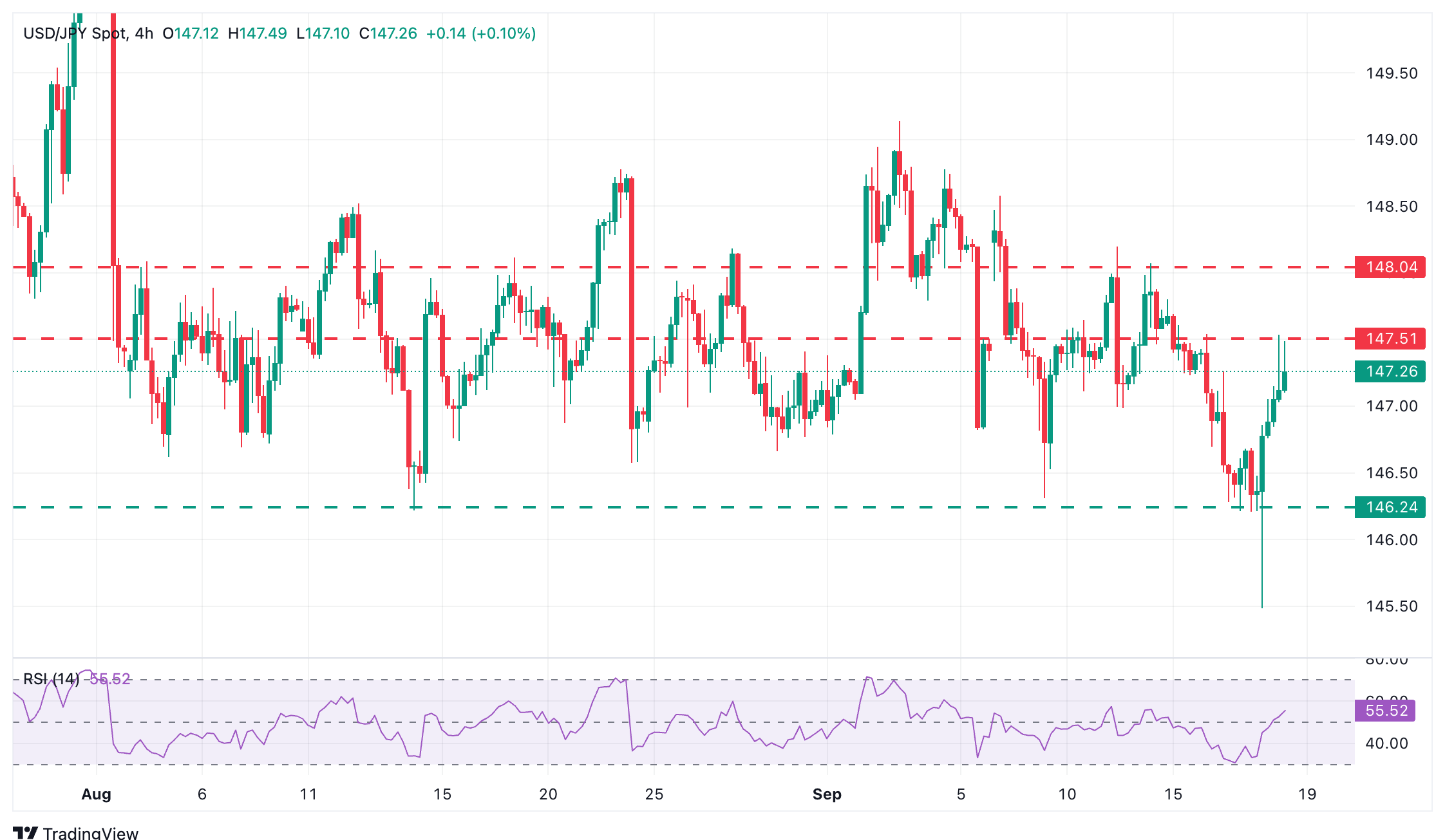Bank of Japan likely to leave rates on hold amid political uncertainty
- The Bank of Japan is widely expected to keep interest rates unchanged at 0.5% for the fifth consecutive meeting on Friday.
- The central bank is likely to wait for Japan’s political uncertainty to fade before hiking interest rates further.
- Markets will be attentive to the BoJ statement, looking for signals of further monetary tightening in October or December.
The Bank of Japan (BoJ) is widely expected to leave its benchmark interest rate unchanged at 0.5% after concluding its two-day September monetary policy meeting on Friday.
BoJ policymakers have reiterated their commitment to hike interest rates further amid the growing inflationary pressure. Still, the bank might wait for the Japanese political uncertainty to fade before resuming its monetary policy normalisation cycle.
Investors will be attentive to BoJ Governor Kazuo Ueda’s press conference to confirm the bank’s commitment to monetary tightening, with Ueda’s comments likely to set the Japanese Yen’s (JPY) near-term direction.
What to expect from the BoJ interest rate decision?
The BoJ is widely expected to maintain its monetary policy unchanged for the fifth consecutive meeting in September.
A trade deal with the United States (US) has eased trade uncertainty and improved the outlook of a strongly trade-oriented economy. Nevertheless, some BoJ officials have warned that it is still too early to assess the impact of US tariffs on Japan’s economy, asking for more time before hiking rates further.
In the meantime, Prime Minister Shigeru Ishiba rattled markets, announcing his departure on September 7, following the defeat in July’s election. Ishiba’s resignation has led the country into a period of political uncertainty that is expected to be resolved at the ruling Liberal Democratic Party (LDP) internal elections on October 4.
Five LDP figures have emerged as potential replacements for Ishiba, with the former economic minister, Sanae Sakaichi, standing out as an active supporter of loose monetary policies, who might pressure the central bank to remain cautious with monetary tightening.
Back to the macroeconomic front, recent data support the BoJ’s hiking plans. Gross Domestic Product (GDP) data revealed that economic growth accelerated in the second quarter, driven by strong exporting activity, while the Unemployment Rate fell to a nearly five-year low of 2.3% in July, with nominal wages growing and pushing inflation higher.
The advanced Tokyo Consumer Price Index (CPI) showed mixed data, with the yearly inflation cooling to 2.6% in August from the previous 2.9% reading, but with the core CPI, which excludes fresh food and energy prices, remaining sticky at 3%.
The stronger-than-expected Japanese trade balance figures reported earlier this week have highlighted the resilience of the exporting sector. The decline in shipments to the US has been offset by increases in trade with Asian and European countries, allowing for a moderately optimistic view about the economic outlook.
How could the Bank of Japan's monetary policy decision affect USD/JPY
Against this backdrop, investors are likely to accept a wait-and-see stance on Friday, with the BoJ keeping interest rates unchanged. Notwithstanding, they will be looking for signals that the option of a rate in late October or December, as the latest, remains on the table. The Japanese Yen might suffer otherwise.
The JPY has strengthened against a softer US Dollar (USD) since late July, when the USD/JPY pair peaked above the 150.00 mark, favoured by narrowing US-Japan yield spreads and investors positioning for a Fed rate cut in September.
In Japan, Governor Ueda reaffirmed the central bank’s plan to gradually tighten its monetary policy in a regular meeting with Prime Minister Ishiba earlier this month. Ueda assured that there is “no change in the stance of rising rates if economy, prices move in line with forecasts.”
Apart from that, the Federal Reserve’s (Fed) dovish turn, confirmed on Wednesday after the US central bank cut rates by 25 basis points as widely anticipated, has highlighted a JPY-supportive monetary policy divergence that will be checked on Friday. The Yen has rallied nearly 3% against the US Dollar from late July lows, although the USD is firming up as we head into the BoJ’s decision.
From a technical standpoint, Haresh Menghani, analyst at FXstreet, points to the resistance area ahead of 147.50 as the level to bet for bulls: "The USD/JPY pair is likely to confront stiff resistance near the 147.40-147.50 region. That said, a sustained strength beyond the said barrier has the potential to lift spot prices to the 148.00 mark en route to the 200-day Simple Moving Average (SMA), currently pegged near the 148.75 zone, the 149.00 mark, and the monthly high, around the 149.15 region.”
To the downside, Menghani sees 146.20 and 146.00 as the key support area: “On the flip side, any meaningful slide might continue to find some support near the 146.20 region ahead of the 146.00 mark. A convincing break below the latter would expose the overnight swing low, around the 145.50-145.45 region, below which the USD/JPY pair could accelerate the fall towards challenging the 145.00 psychological mark.”
USD/JPY 4-hour chart

Economic Indicator
BoJ Interest Rate Decision
The Bank of Japan (BoJ) announces its interest rate decision after each of the Bank’s eight scheduled annual meetings. Generally, if the BoJ is hawkish about the inflationary outlook of the economy and raises interest rates it is bullish for the Japanese Yen (JPY). Likewise, if the BoJ has a dovish view on the Japanese economy and keeps interest rates unchanged, or cuts them, it is usually bearish for JPY.
Read more.Next release: Fri Sep 19, 2025 03:00
Frequency: Irregular
Consensus: 0.5%
Previous: 0.5%
Source: Bank of Japan
Bank of Japan FAQs
The Bank of Japan (BoJ) is the Japanese central bank, which sets monetary policy in the country. Its mandate is to issue banknotes and carry out currency and monetary control to ensure price stability, which means an inflation target of around 2%.
The Bank of Japan embarked in an ultra-loose monetary policy in 2013 in order to stimulate the economy and fuel inflation amid a low-inflationary environment. The bank’s policy is based on Quantitative and Qualitative Easing (QQE), or printing notes to buy assets such as government or corporate bonds to provide liquidity. In 2016, the bank doubled down on its strategy and further loosened policy by first introducing negative interest rates and then directly controlling the yield of its 10-year government bonds. In March 2024, the BoJ lifted interest rates, effectively retreating from the ultra-loose monetary policy stance.
The Bank’s massive stimulus caused the Yen to depreciate against its main currency peers. This process exacerbated in 2022 and 2023 due to an increasing policy divergence between the Bank of Japan and other main central banks, which opted to increase interest rates sharply to fight decades-high levels of inflation. The BoJ’s policy led to a widening differential with other currencies, dragging down the value of the Yen. This trend partly reversed in 2024, when the BoJ decided to abandon its ultra-loose policy stance.
A weaker Yen and the spike in global energy prices led to an increase in Japanese inflation, which exceeded the BoJ’s 2% target. The prospect of rising salaries in the country – a key element fuelling inflation – also contributed to the move.

